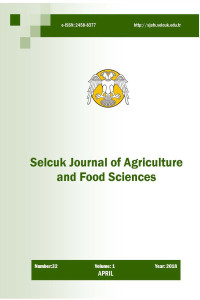Effects of Safflower Cultivars (Carthamus tinctorius L.) on Yield and Yield Components of Different Row and Row Spaces
Abstract
Safflower (Carthamus tinctorius L.) is an annual plant with number of thistle or thistle less cultivars with broad leaves, oil and different flower colored varieties. They are tolerant to drought with varying oil percentage of 30-50%. It is known that demand of vegetable oil is increasing every day. Therefore, safflower is an increasingly important plant among the oil seed plants. The aim of the study was to determine the efficiency of the safflower cultivars by maintaining 20, 30, 40 cm row to row and 5, 10, 15 cm plant to plant distance under Ankara conditions during 2015 using cv. Ayaz and Linas. Parameters like plant height (cm), number of lateral branches attached to the main stem, number of capsules per plant, number of seeds per capsule, seed yield (kg da-1) and oil percentage (%) were examined. Significant interactions were noted among all evaluated parameters for row spacings × plant to plant distances × cultivars. When the average values were taken into consideration, the highest yield per plant was found in cv Ayaz with yield of 46.53 g. Maximum seed yield of 157.7 kg da-1 and oil percentage of 47.90% was also determined on cv. Ayaz using 30×10 cm. When the results of the research were compared collec-tively, it was concluded that cv. Ayaz was more advantageous compared to the cv. Linas under the tested climate and soil conditions.
Farklı Sıra Arası ve Sıra Üzeri Mesafelerin Aspir (Carthamus tinctorius L.) Çeşitlerinin Verim ve Verim Ögelerine Etkileri
Abstract
Aspir (Carthamus tinctorius L.), tek yıllık, geniş yapraklı, değişik renklerde çiçeklere sahip, dikenli ve dikensiz çeşitleri olan, kurağa dayanım bakımından avantajlı, yağ oranı % 30-50 arasında değişiklik gösteren bir yağ bitkisidir. Ülkemizde bitkisel yağ açığımızın gün geçtikçe arttığı herkesçe bilinen bir gerçektir. Bu nedenlerden dolayı aspir yağlı tohumlu bitkiler arasında giderek önemi artan bir bitki durumundadır. Bu çalışma, aspir çeşitlerinin (Ayaz ve Linas) farklı sıra arası (20, 30, 40 cm) ve sıra üzeri mesafelerde (5,10,15 cm) verim ve verim ögelerinin belirlenmesi amacıyla, Ankara koşullarında 2015 yılı aspir vejetasyon döneminde (Nisan-Ağustos) üç tekerrürlü olarak yürütülmüştür. Araştırmada bitki boyu (cm), ana sapa bağlı yan dal sayısı (adet), bitkide tabla sayısı (adet), tablada tohum sayısı (adet), bitki başına tohum verimi (g), tohum verimi (kg da-1), yağ oranı (%) değerleri incelenmiştir. İncelenen karakterler bakımından sıra arası × sıra üzeri × çeşit interaksiyonu önemli düzeyde etkileşim göstermiştir. Ortalama değerlere bakıldığında ise, en yüksek bitki başına tohum verimi 46.53 g da-1 ile 30×10 cm mesafede ve Ayaz çeşidinde saptanmıştır. En yüksek tohum verimi 157.7 kg da-1 ve en yüksek yağ oranı da %47.90 ile yine Ayaz çeşidinde ve 30×10 cm mesafede belirlenmiştir. Sonuç olarak, çalışmanın yürütüldüğü iklim ve toprak koşullarında Ayaz çeşidinin Linas çeşidine göre daha avantajlı sonuçlar gösterdiği ve en uygun ekim sıklığının 30×10 cm olduğu kanısına varılmıştır.
Details
| Primary Language | English |
|---|---|
| Subjects | Agronomy |
| Journal Section | Research Article |
| Authors | |
| Publication Date | April 27, 2018 |
| Submission Date | August 11, 2017 |
| Published in Issue | Year 2018 Volume: 32 Issue: 1 |
Selcuk Agricultural and Food Sciences is licensed under a Creative Commons Attribution-NonCommercial 4.0 International License (CC BY NC).


